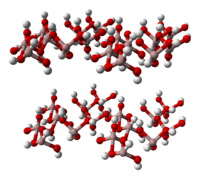
Photo from wikipedia
Abstract Macroscopic batch experiments and microscopic spectroscopic characterization by powder X-ray diffraction (p-XRD), Fourier transform infrared spectroscopy (FTIR) and X-ray photoelectron spectroscopy (XPS) were employed to accurately study the phosphate… Click to show full abstract
Abstract Macroscopic batch experiments and microscopic spectroscopic characterization by powder X-ray diffraction (p-XRD), Fourier transform infrared spectroscopy (FTIR) and X-ray photoelectron spectroscopy (XPS) were employed to accurately study the phosphate adsorption process onto lanthanum hydroxide adsorbent. The relatively low La release after phosphate adsorption suggested the formation of surface co-precipitation of lanthanum phosphate beyond the Lewis acid-base interaction under the acidic conditions. The maximum adsorption capacities calculated by the Langmuir isotherm at pH 4.0 and 8.0 were 122.0 mg/g and 109.9 mg/g, respectively. Cl−, SO42– and HCO3– on phosphate removal negligibly impacted on phosphate adsorption, while acetate slightly retarded the adsorption. The fitted FTIR spectra of P−O stretching vibration bands in 900-1200 cm−1 range indicated that diprotonated bidentate binuclear or monoprotonated bidentate mononuclear complexes were the dominant surface configurations at pH 4-9. Diprotonated bidentate binuclear complexes were dominant at pH 3 and monoprotonated bidentate binuclear complexes were the major configurations at pH > 9. The high resolution scans of La 3d, O 1s and P 2p spectra before and after phosphate adsorption and lanthanum phosphate indicated that inner-sphere surface complexes formed through the ligand exchange reaction, which were further determined to be rhabdophane (LaPO4∙0.5H2O) by p-XRD analysis.
Journal Title: Applied Surface Science
Year Published: 2021
Link to full text (if available)
Share on Social Media: Sign Up to like & get
recommendations!